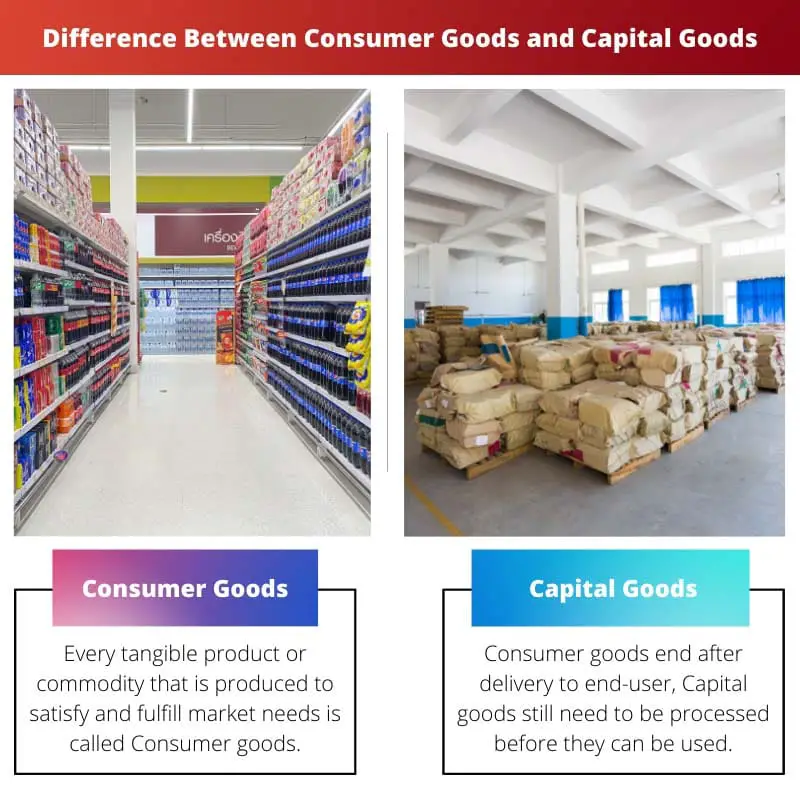Consumer goods are directly used by consumers and have no future productive use (e.g., food, clothing), while capital goods are used in production processes for creating other goods (e.g., machinery, buildings).
Key Takeaways
- Consumer goods are goods that individuals use for personal use or consumption.
- Capital goods are goods that are used in the production of other goods and services.
- Consumer goods are used up or consumed over time, while capital goods are durable and long-lasting.
Consumer Goods vs Capital Goods
Consumer goods are products that individuals purchase for personal use or consumption. Capital goods are products that are used in the production of other goods and services. Consumer goods are influenced by individual statistics, unlike capital goods which are influenced by business investment.

Comparison Table
| Feature | Consumer Goods | Capital Goods |
|---|---|---|
| Definition | Goods purchased by individuals for personal consumption. | Goods purchased by businesses to produce other goods or services. |
| Purpose | Satisfy individual needs and wants. | Facilitate the production process and generate income for businesses. |
| Examples | Food, clothing, furniture, appliances, electronics, entertainment products. | Buildings, machinery, equipment, vehicles, tools, office supplies. |
| Durability | Generally less durable and have a shorter lifespan. | Generally more durable and have a longer lifespan. |
| Frequency of purchase | Purchased more frequently. | Purchased less frequently and in larger quantities. |
| Demand | High demand, influenced by consumer preferences and trends. | Lower demand, mainly driven by business needs and investment cycles. |
| Pricing | Generally less expensive than capital goods. | Generally more expensive than consumer goods. |
| Ownership | Owned by individuals. | Owned by businesses. |
| Economic role | Drive consumer spending and economic growth. | Contribute to production and economic growth. |
| Impact on GDP | Counted in personal consumption expenditures (PCE) component of GDP. | Counted in gross fixed investment (GFI) component of GDP. |
| Depreciation | Not depreciated for tax purposes. | Depreciated over time for tax purposes. |
What are Consumer Goods?
Consumer goods, or final goods, are products purchased by individuals for their personal use or consumption. They are the end products of the production chain and are not used to produce other goods. Consumer goods are vital to the economy, driving consumer spending and contributing to economic growth.
Here are some key characteristics of consumer goods:
- Purpose: Satisfy individual needs and wants. These needs can be basic (e.g., food, clothing, shelter) or more complex (e.g., entertainment, leisure, luxury items).
- Demand: Consumer goods are in high demand, driven by consumer preferences, income levels, and trends.
- Durability: Consumer goods vary in durability, with some items having a shorter lifespan (e.g., food, clothing) and others being more durable (e.g., furniture, appliances).
- Frequency of purchase: Consumer goods are purchased more frequently than capital goods, with some items being replenished regularly (e.g., groceries) and others purchased less frequently (e.g., furniture).
- Pricing: Consumer goods are priced based on their production cost, perceived value to the consumer, and market competition.
- Examples: Food, clothing, furniture, appliances, electronics, entertainment products, cosmetics, personal care products, etc.
Consumer goods can be further categorized by their durability and consumption pattern:
- Durable goods: These goods have a lifespan of more than three years and are expected to be used repeatedly. Examples include furniture, appliances, electronics, and vehicles.
- Non-durable goods: These goods have a lifespan of less than three years and are consumed quickly. Examples include food, beverages, clothing, and cosmetics.
- Convenience goods: These goods are purchased frequently and require minimal shopping effort. Examples include groceries, snacks, and toiletries.
- Shopping goods: These goods are purchased less frequently and require comparison shopping before purchase. Examples include furniture, appliances, and clothing.
- Specialty goods: These goods have unique characteristics and are sought out by a specific group of consumers. Examples include luxury cars, designer clothing, and collectibles.

What are Capital Goods?
Capital goods, also known as producer goods, fixed assets, or property, plant, and equipment (PPE), are products purchased by businesses to produce other goods or services. They are not used for final consumption but contribute to the production process, enabling businesses to generate income.
Here are some key characteristics of capital goods:
Purpose:
- Facilitate the production process and contribute to the overall productivity of a business.
- Generate income for businesses by enabling them to produce and sell goods or services.
Demand:
- Lower demand than consumer goods is driven mainly by business needs and investment cycles.
- Demand fluctuates depending on economic conditions, business confidence, and technological advancements.
Durability:
- Generally more durable than consumer goods and have a longer lifespan, lasting several years or even decades.
- Requires periodic maintenance and repairs to ensure optimal performance and longevity.
Frequency of purchase:
- Purchased less frequently than consumer goods and in larger quantities, depending on the size and needs of the business.
- Businesses invest in capital goods when they anticipate increased production or need to replace outdated equipment.
Pricing:
- Generally more expensive than consumer goods due to their higher durability, complexity, and specialized features.
- Businesses consider the cost-benefit analysis and expected return on investment before purchasing capital goods.
Examples:
- Buildings (factories, offices, warehouses)
- Machinery and equipment (production lines, assembly robots, computers, trucks)
- Vehicles (delivery trucks, construction equipment)
- Tools and office equipment (hand tools, software, furniture)
Capital goods can be further categorized by their function:
- Production equipment: Directly involved in the production process, such as machinery, assembly lines, and tools.
- Infrastructure: Provides the physical foundation for production activities, such as buildings, utilities, and transportation networks.
- Information technology: Supports business operations and decision-making, such as computers, software, and telecommunication systems.

Main Differences Between Consumer Goods and Capital Goods
- Purpose:
- Consumer Goods: Consumer goods are products that individuals and households purchase for personal use and consumption. They satisfy the immediate needs and desires of consumers.
- Capital Goods: Capital goods, also known as producer goods or intermediate goods, are items used by businesses and industries to produce other goods and services. They are not intended for personal consumption.
- Usage:
- Consumer Goods: Consumer goods are used directly by consumers for their own satisfaction and enjoyment. They have a short-term utility and are consumed or used up relatively quickly.
- Capital Goods: Capital goods are used by businesses as tools or equipment in production. They are considered long-term assets and contribute to producing other goods and services over an extended period.
- Examples:
- Consumer Goods: Examples of consumer goods include food, clothing, electronics, automobiles, furniture, and personal care products.
- Capital Goods: Examples of capital goods include machinery, factory equipment, vehicles for business purposes, computer servers for data centers, and industrial robots.
- Durability:
- Consumer Goods: Consumer goods are designed to be used for a relatively short period, and their durability varies depending on the product type.
- Capital Goods: Capital goods are designed to be durable and have a longer lifespan. They are expected to withstand frequent use in production processes.
- Depreciation:
- Consumer Goods: Consumer goods depreciate in value over time, especially after use, and may lose their value relatively quickly.
- Capital Goods: Capital goods also depreciate but over a longer period. Their value is spread over their useful life and may be written off as a business expense.
- Investment vs. Consumption:
- Consumer Goods: Spending on consumer goods is considered consumption expenditure. It represents personal consumption and does not directly contribute to economic growth.
- Capital Goods: Investment in capital goods represents a significant part of business expenditure. It contributes to economic growth by increasing a company’s production capacity and efficiency.
- Economic Impact:
- Consumer Goods: Consumer spending on these goods can drive short-term economic activity, but it does not necessarily lead to long-term economic growth.
- Capital Goods: Investment in capital goods can stimulate economic growth by increasing productivity and creating a foundation for future production and innovation.
- Examples in Business:
- Consumer Goods: Retail businesses primarily deal with consumer goods and cater to individual consumers.
- Capital Goods: Manufacturing and industrial businesses are more likely to invest in capital goods to support their production processes.

- https://link.springer.com/chapter/10.1007/978-1-349-81529-6_9
- https://academic.oup.com/oep/article-abstract/15/3/217/2360262
- https://www.ingentaconnect.com/content/mcb/007/1993/00000007/00000003/art00005
The article provides a comprehensive overview of consumer and capital goods, offering valuable insights into the economic significance of both categories.
I completely agree. The article’s focus on economic implications adds depth to the comprehension of consumer and capital goods in the economic landscape.
Absolutely, the article’s emphasis on the economic roles and contributions of consumer and capital goods enriches the reader’s understanding.
The economic role and impact on GDP section is an eye-opener, depicting the significant contributions of both consumer and capital goods to the economy.
I couldn’t agree more. The article provides valuable insights into the economic functions served by these goods.
Absolutely, the article effectively highlights the relationship between consumer spending, economic growth, and the role of capital goods in generating income for businesses.
The article is not only insightful but also elucidates the economic implications of consumer and capital goods, making it a must-read for anyone interested in economic theory.
Absolutely, the article’s emphasis on economic implications adds depth to the understanding of consumer and capital goods.
I completely agree. The article’s focus on the economic roles and impact on GDP provides a holistic view of the subject matter.
The detailed categorizations of both consumer and capital goods make this article an excellent resource for anyone seeking clarity on this topic.
I agree. The categorizations further enhance the reader’s comprehension of these fundamental economic concepts.
Absolutely, the comprehensive breakdown and examples make the information highly accessible and understandable.
The explanations of consumer and capital goods, along with their categorizations, are presented coherently, making it a valuable read for individuals interested in economics.
Absolutely, the article’s clarity and coherence make it an excellent reference for understanding the significance of consumer and capital goods in the economy.
This article provides a clear and concise understanding of consumer and capital goods, making it an invaluable resource for learning and reference.
The distinction between consumer and capital goods is crystal clear now. The examples and categorizations helped me grasp the concept effortlessly.
Exactly, the article’s content leaves no room for ambiguity, providing a thorough understanding and clarification of these terms.
Indeed, the differentiation between durable and non-durable consumer goods, along with the breakdown of production equipment and infrastructure as capital goods, is extremely informative.
The comparison table succinctly illustrates the differentiation between consumer and capital goods, making it easier for readers to comprehend the nuances of each category.
I couldn’t agree more. The table serves as an effective visual aid, enhancing the understanding of consumer and capital goods.
The article does a great job explaining the difference between consumer and capital goods, breaking down each category’s characteristics and examples.
I couldn’t agree more. The detailed comparison table provides a comprehensive understanding of these concepts.
The article’s in-depth analysis of consumer and capital goods, coupled with a clear presentation, ensures a comprehensive understanding of these economic concepts.
Absolutely, the article meticulously dissects the characteristics and roles of consumer and capital goods, making it an enlightening read.
I couldn’t agree more. The analytical approach provides a profound insight into the economic significance of both consumer and capital goods.